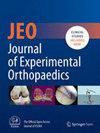Clinical outcomes and biomechanics in bicruciate-retaining total knee arthroplasty
Abstract
Purpose
To clarify the influence of biomechanics on post-operative clinical outcomes in bicruciate-retaining total knee arthroplasty (BCR-TKA).
Methods
Severe medial osteoarthritis who underwent BCR-TKA were examined. Each patient was asked to perform a squat (weight-bearing [WB]) and active assisted knee flexion (non-WB [NWB]) under single fluoroscopy surveillance. A 2D-to-3D registration technique was used. Patients were divided into two groups based on their 1-year post-operative patient-reported outcome measures (PROMs) using hierarchical cluster analysis. The rotational alignment on computed tomography, anterior stability at 30° of knee flexion, axial rotation of the femur relative to the tibial component and anteroposterior translation of the medial and lateral femorotibial contact points were measured.
Results
Components did not significantly differ between the groups, with 1.6 ± 5.0° and 5.4 ± 4.7° of femoral internal rotation in the low PROM (N = 28) and high PROM (N = 8) groups, respectively. Moreover, anterior stability did not significantly differ (low PROM: 4.9 ± 1.4 mm, high PROM: 5.3 ± 1.0 mm). The knee externally rotated from 0° to 70° and from 50° to 110° of flexion during WB and NWB, respectively. The low-PROM group exhibited more external rotation across all ranges of motion. Medial contact points moved backwards from 0° to 30° of flexion during WB, forward from 30° to 100° of flexion, and backwards from 100° to 110° of flexion. The low-PROM group was positioned more forward throughout the full range of motion during WB. Lateral contact points moved backwards at 0−30° of flexion, forward at 70−100° of flexion, and backwards at 100−110° of flexion during WB, while there was backward movement at 50° of flexion during NWB. Both activities exhibited a more posterior position in the low-PROM group throughout the full range of motion.
Conclusion
The femoral component in the low-PROM group was externally rotated across all ranges of motion, and the lateral contact points were posteriorly located in BCR-TKA.
Level of Evidence
Level II, prospective cohort study.


 求助内容:
求助内容: 应助结果提醒方式:
应助结果提醒方式:


